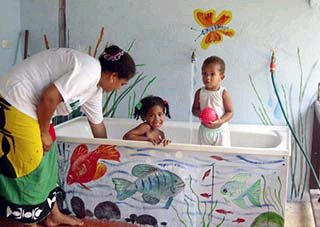
(Whoever wrote in about the oranges, thanks. I’ve never heard of them. They were in the orange bin at Walmart this weekend. I’m always looking for adventures in food for the kids. The name “blood orange” is a bit obnoxious. Too bad they are not available around Halloween!)
While reading the news, I stumbled over this article. I can’t imagine taking children out in anything but a school bus with a professional driver. Ten years ago we met Miss Sandy. She’s been our driver ever since. Can’t think what we’d do without her. She has her own school bus and is a driver for the county schools.
We go farther than any school in the area. We travel three hours in one direction in the summer, and the idea that someone not used to driving something as big as a school bus would be “discovering” all the oddities and all the problems with 30-40 children aboard makes my skin go cold. We drive through a lot of wilderness. What happens if the “discovery” goes bad? In all the years, in all the miles we’ve traveled, Miss Sandy’s bus, new and energy efficient – for a bus – has never had a single problem.
The vans that are spoken of in this article are a target waiting to be struck in traffic. They are low, long, and built like a car. I doubt I would want one of my grandchildren to ride in one. I think they are horribly dangerous.
If a child is too young to travel by school bus, he is too young to take out. The very idea that he would benefit from a field trip is silly. The idea of field trip is to teach. How can a teacher teach a child who just wants to run?
If you are thinking of a series of field trips, hire a bus and a licensed insured driver. Pay her well and treat her well, and she will be there when you need her.
What to Look for When Buying Transportation for Child Care Centers
By Joe Craver
Transportation for a child care center is a major investment. There are a number of options available, so it’s wise to do your homework before making any decisions. Below are a few key factors every administrator should consider before purchasing vehicles for use at a child care center.
In the past, 15-passenger vans were the vehicle of choice for many child care operations. That is changing as safety concerns have caused the federal government and many states to impose restrictions on the use of vans and other non-compliant vehicles for transporting children. In August 2005 President Bush signed the Transportation Equity Act for the 21st Century, which, among other things, prohibits preprimary, primary and secondary schools from purchasing new or used non-compliant vehicles for transporting school children.
While the federal law does not specifically address child care centers, center directors should be aware of the increasing restrictions and potential liability of operating noncompliant vehicles. It can be argued that a child care facility that promotes itself as a learning center or early childhood education center should meet the same transportation guidelines as a school. If you operate a non-compliant vehicle, be sure to check with your insurance provider and review state and federal regulations regarding the use of vehicles at your center.
A popular choice for a fully compliant vehicle is the multi-functional school activity bus (MFSAB). These buses meet the same federal safety guidelines as school buses but are not required to have stop-arms or traffic-control lights, and in most states are not required to be yellow. Studies have shown that school buses (including MFSABs) are the safest form of surface transportation. The National Safety Council estimates that the risk of death to a passenger traveling in a school bus is 172 times less than someone traveling in an automobile.
School buses are built with sturdy steel roll cages so they can withstand a rollover much better than other vehicles. In addition, seating is designed to compartmentalize passengers in the event of an accident and seat backs are engineered to absorb energy. School buses are also required to have multiple emergency exits and rugged body construction for side impact protection.
Start by determining how many children you need to transport. A type A small school bus, or MFSAB, often is the best choice. These mini-buses hold from 14 to 30 passengers (plus driver), depending on the length of the bus and seating configuration. Small centers can often get by using a single rear-wheel model with an 84-inch body width, which can hold up to 14 passengers plus the driver. For increased capacity, consider dual rear-wheel type A buses with a 96-inch body width, which typically seat from 19 to 30 passengers. For centers that need full-size school buses, type C conventional buses seat up to 81 passengers.
All of these vehicles are sold by full-service bus dealerships, while some of the smaller units can be found at a local car dealership. Keep in mind that, if the vehicle carries more than 15 people, the driver must have a commercial driver’s license (CDL), which requires extra driver training and certification. Drivers with CDL certification often command a higher pay rate. The CDL is not required for vehicles designed to carry less than 14 passengers, but it is highly recommended that all drivers receive additional training and thorough background checks.
When pricing transportation options, be sure to consider the price of the vehicle plus the cost of insurance. Often the least expensive vehicles require the most expensive insurance. For example, the cost of insuring non-compliant vehicles has risen dramatically. On the other hand, mini-buses are recognized as being a very safe form of transportation so insurance rates can be quite reasonable.
MFSAB prices range from about $32,000 for a basic model to $50,000 for a model with options such as high-capacity air conditioning, integrated child seats, acoustical ceiling and shoulder/lap belts. Centers may want to consider a 30-passenger mini-bus instead of two 14- passenger buses to save on maintenance and driver costs if a one-bus plan meets their transportation needs.
Just as with buying an automobile, factor in the cost of maintenance and repair over the life of the vehicle. Compare warranties and check to see if the vehicle can be repaired locally.
When purchasing a mini-bus from an auto dealership rather than a bus dealership, inquire about the manufacturer of both the chassis and the body. Most mini-buses are built on GMC, Chevrolet or Ford chassis, which makes them easy to service at most auto or light-truck dealerships. The bodies, however, are made by various bus manufacturers, so ask about the nearest repair center in case the bus requires body work or replacement windows. Look for a body made by a reputable bus manufacturer and one that has repair facilities within a reasonable distance.
Finding vehicles that are just right for your child care center isn’t difficult. It just takes a little time, research and a dealer who will answer your questions and stand behind the product when it comes time for service.
Joe Craver is the small bus sales manager at Thomas Built Buses Inc. Thomas Built Buses manufactures a complete line of buses for the commercial transit, school bus and specialty-vehicle markets. For more information, visit Tomas Bus







